NUR131: Research Workbook Assignment, Semester 2 2019, Part A & B
VerifiedAdded on 2022/09/18
|15
|3749
|40
Homework Assignment
AI Summary
This document presents a student's completed NUR131 Task 2 Research Workbook assignment from Semester 2, 2019, contributing 35% to the overall grade. Part A includes summaries of eight research presentations on topics like rural obstetric units, narrative inquiry, evidence-based health literature, IV devices, women and ECT, psychosocial support for diabetics, infant mortality, and mobile health interventions for mothers. Each presentation summary includes the date, presenter, title, description of topics covered, and reflection on its application to future practice. Part B is a research critique of the article "Not 'just' an intravenous line: Consumer perspectives on peripheral intravenous cannulation (PIVC)" by Cooke et al. (2018). The critique addresses the study's purpose, research question using PICO format, design, sampling and recruitment procedures, and data collection methods. The student provides detailed answers and analysis for each section of the critique, demonstrating an understanding of research methodologies and critical evaluation of the chosen article.
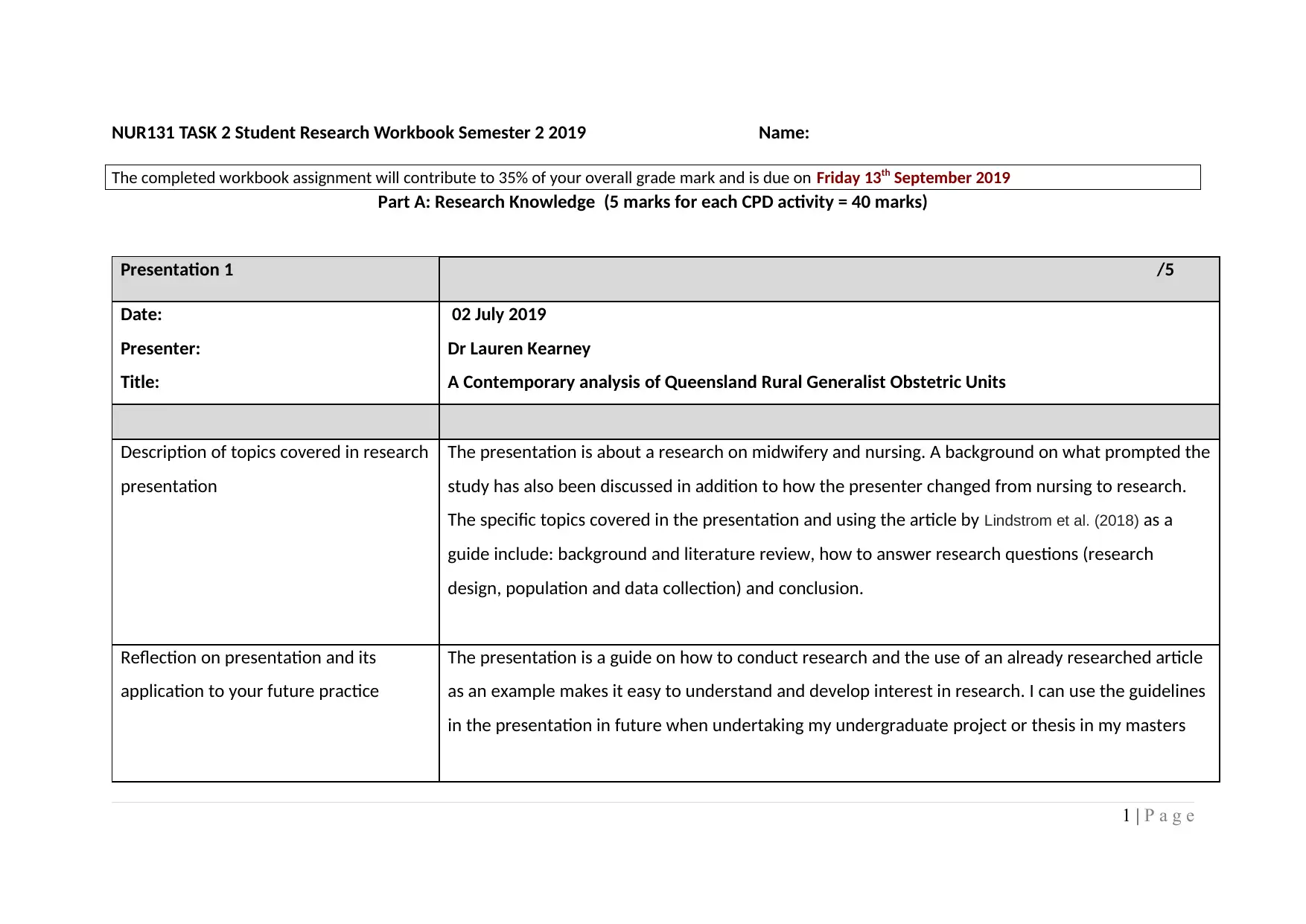
NUR131 TASK 2 Student Research Workbook Semester 2 2019 Name:
The completed workbook assignment will contribute to 35% of your overall grade mark and is due on Friday 13th September 2019
Part A: Research Knowledge (5 marks for each CPD activity = 40 marks)
Presentation 1 /5
Date:
Presenter:
Title:
02 July 2019
Dr Lauren Kearney
A Contemporary analysis of Queensland Rural Generalist Obstetric Units
Description of topics covered in research
presentation
The presentation is about a research on midwifery and nursing. A background on what prompted the
study has also been discussed in addition to how the presenter changed from nursing to research.
The specific topics covered in the presentation and using the article by Lindstrom et al. (2018) as a
guide include: background and literature review, how to answer research questions (research
design, population and data collection) and conclusion.
Reflection on presentation and its
application to your future practice
The presentation is a guide on how to conduct research and the use of an already researched article
as an example makes it easy to understand and develop interest in research. I can use the guidelines
in the presentation in future when undertaking my undergraduate project or thesis in my masters
1 | P a g e
The completed workbook assignment will contribute to 35% of your overall grade mark and is due on Friday 13th September 2019
Part A: Research Knowledge (5 marks for each CPD activity = 40 marks)
Presentation 1 /5
Date:
Presenter:
Title:
02 July 2019
Dr Lauren Kearney
A Contemporary analysis of Queensland Rural Generalist Obstetric Units
Description of topics covered in research
presentation
The presentation is about a research on midwifery and nursing. A background on what prompted the
study has also been discussed in addition to how the presenter changed from nursing to research.
The specific topics covered in the presentation and using the article by Lindstrom et al. (2018) as a
guide include: background and literature review, how to answer research questions (research
design, population and data collection) and conclusion.
Reflection on presentation and its
application to your future practice
The presentation is a guide on how to conduct research and the use of an already researched article
as an example makes it easy to understand and develop interest in research. I can use the guidelines
in the presentation in future when undertaking my undergraduate project or thesis in my masters
1 | P a g e
Paraphrase This Document
Need a fresh take? Get an instant paraphrase of this document with our AI Paraphraser

Presentation 2 /5
Date:
Presenter:
Title:
8th July 2019
Dr Ann Framp
A narrative Inquiry into the experiences of one family’s predisposition to hereditary diffuse gastric
cancer
Description of topics covered in research
presentation
The presentation is about the importance of the study by Ann Framp and its contribution to the
existing knowledge on genetically inheritable diseases. Ethical considerations have also been
analysed based on the treaty of Waitangi. The methodology used was a narrative inquiry and it is
appropriate for human studies
Reflection on presentation and its
application to your future practice
The study is important because it contributes to existing knowledge about genetically inheritable
diseases. Gastric cancer is hereditary and there are 80% chance of developing the disease in the
entire life time at an onset age of 37 years. Furthermore, the treaty of Waitangi is appropriate for
human studies. I can use narrative inquiry in the future when carrying out a project dealing with
sensitive human experiences because it allows the recreation and representation of meaningful
stories.
2 | P a g e
Date:
Presenter:
Title:
8th July 2019
Dr Ann Framp
A narrative Inquiry into the experiences of one family’s predisposition to hereditary diffuse gastric
cancer
Description of topics covered in research
presentation
The presentation is about the importance of the study by Ann Framp and its contribution to the
existing knowledge on genetically inheritable diseases. Ethical considerations have also been
analysed based on the treaty of Waitangi. The methodology used was a narrative inquiry and it is
appropriate for human studies
Reflection on presentation and its
application to your future practice
The study is important because it contributes to existing knowledge about genetically inheritable
diseases. Gastric cancer is hereditary and there are 80% chance of developing the disease in the
entire life time at an onset age of 37 years. Furthermore, the treaty of Waitangi is appropriate for
human studies. I can use narrative inquiry in the future when carrying out a project dealing with
sensitive human experiences because it allows the recreation and representation of meaningful
stories.
2 | P a g e

Presentation 3 /5
Date:
Presenter:
Title:
15th July 2019
Roger Carter
Finding and using evidence-based health literature in USC website focusing on nursing
Description of topics covered in research
presentation
The topics covered in this presentation include; understanding evidence-based practice and
literature, levels and types of evidence, using PICO to formulate research strategy, choice of
databases, search engines and evaluation of outcomes. The presentation discusses where to find
books, journal articles and an example of the list of databases. An example of the pyramid hierarchy
of evidence in addition to a brief summary of each type of article have also been provided. JBI grades
of recommendation and generating PICO keywords have also been explained.
Reflection on presentation and its
application to your future practice
The presentation is very important when conducting research because it provides basic and
fundamental skills required for scientific research. It provides a comprehensive skill on how to begin
and continue with research. I will use the PICO format presented in the formulation of my research
question at the end of the semester
3 | P a g e
Date:
Presenter:
Title:
15th July 2019
Roger Carter
Finding and using evidence-based health literature in USC website focusing on nursing
Description of topics covered in research
presentation
The topics covered in this presentation include; understanding evidence-based practice and
literature, levels and types of evidence, using PICO to formulate research strategy, choice of
databases, search engines and evaluation of outcomes. The presentation discusses where to find
books, journal articles and an example of the list of databases. An example of the pyramid hierarchy
of evidence in addition to a brief summary of each type of article have also been provided. JBI grades
of recommendation and generating PICO keywords have also been explained.
Reflection on presentation and its
application to your future practice
The presentation is very important when conducting research because it provides basic and
fundamental skills required for scientific research. It provides a comprehensive skill on how to begin
and continue with research. I will use the PICO format presented in the formulation of my research
question at the end of the semester
3 | P a g e
⊘ This is a preview!⊘
Do you want full access?
Subscribe today to unlock all pages.

Trusted by 1+ million students worldwide

Presentation 4 /5
Date:
Presenter:
Title:
23rd July 2019
Professor Marianne Wallis
Peripheral Intravenous Devices: an example of a clinical research program
Description of topics covered in research
presentation
The presentation discusses the use of IV catheters, the difficulties of intravenous catheters, the
consequence of catheters, how to use peripheral IVs, MV analysis among others.
Reflection on presentation and its
application to your future practice
IV catheters are the most common used types of insertions and lack of skills in their use leads to
serious consequences such as phlebitis, infection, and occlusion. Therefore, this presentation is
important in nursing practice because shows the common challenges of IV catheters and the most
appropriate ways of having successful IV catheters. The information in this presentation is important
because I can apply it in the future as a healthcare practitioner
Presentation 5 /5
Date:
Presenter:
Title:
30th July 2019
Dr Karen-Ann Clark
Women with depression: making meaning and decisions about electro-convulsive therapy. A
4 | P a g e
Date:
Presenter:
Title:
23rd July 2019
Professor Marianne Wallis
Peripheral Intravenous Devices: an example of a clinical research program
Description of topics covered in research
presentation
The presentation discusses the use of IV catheters, the difficulties of intravenous catheters, the
consequence of catheters, how to use peripheral IVs, MV analysis among others.
Reflection on presentation and its
application to your future practice
IV catheters are the most common used types of insertions and lack of skills in their use leads to
serious consequences such as phlebitis, infection, and occlusion. Therefore, this presentation is
important in nursing practice because shows the common challenges of IV catheters and the most
appropriate ways of having successful IV catheters. The information in this presentation is important
because I can apply it in the future as a healthcare practitioner
Presentation 5 /5
Date:
Presenter:
Title:
30th July 2019
Dr Karen-Ann Clark
Women with depression: making meaning and decisions about electro-convulsive therapy. A
4 | P a g e
Paraphrase This Document
Need a fresh take? Get an instant paraphrase of this document with our AI Paraphraser
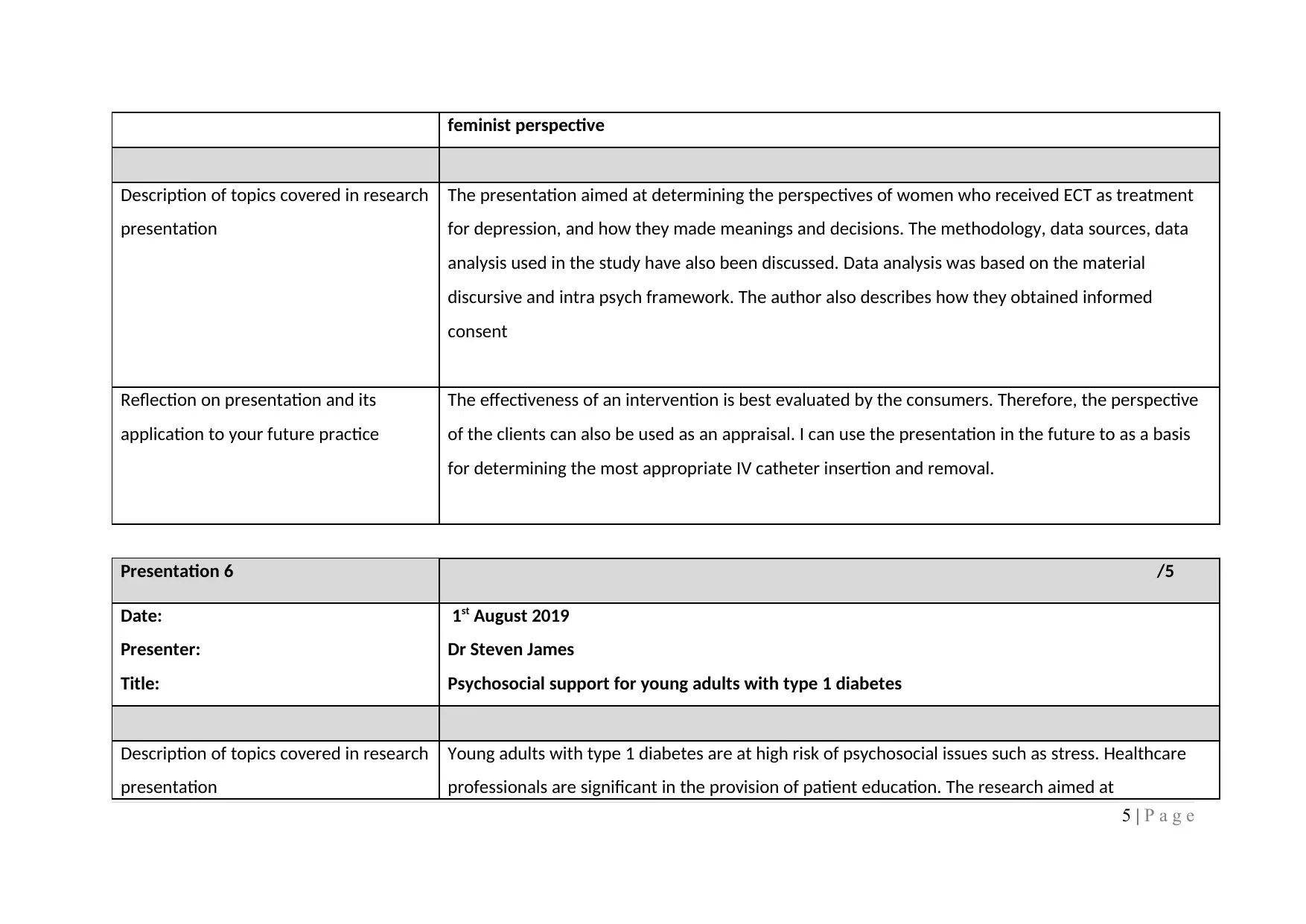
feminist perspective
Description of topics covered in research
presentation
The presentation aimed at determining the perspectives of women who received ECT as treatment
for depression, and how they made meanings and decisions. The methodology, data sources, data
analysis used in the study have also been discussed. Data analysis was based on the material
discursive and intra psych framework. The author also describes how they obtained informed
consent
Reflection on presentation and its
application to your future practice
The effectiveness of an intervention is best evaluated by the consumers. Therefore, the perspective
of the clients can also be used as an appraisal. I can use the presentation in the future to as a basis
for determining the most appropriate IV catheter insertion and removal.
Presentation 6 /5
Date:
Presenter:
Title:
1st August 2019
Dr Steven James
Psychosocial support for young adults with type 1 diabetes
Description of topics covered in research
presentation
Young adults with type 1 diabetes are at high risk of psychosocial issues such as stress. Healthcare
professionals are significant in the provision of patient education. The research aimed at
5 | P a g e
Description of topics covered in research
presentation
The presentation aimed at determining the perspectives of women who received ECT as treatment
for depression, and how they made meanings and decisions. The methodology, data sources, data
analysis used in the study have also been discussed. Data analysis was based on the material
discursive and intra psych framework. The author also describes how they obtained informed
consent
Reflection on presentation and its
application to your future practice
The effectiveness of an intervention is best evaluated by the consumers. Therefore, the perspective
of the clients can also be used as an appraisal. I can use the presentation in the future to as a basis
for determining the most appropriate IV catheter insertion and removal.
Presentation 6 /5
Date:
Presenter:
Title:
1st August 2019
Dr Steven James
Psychosocial support for young adults with type 1 diabetes
Description of topics covered in research
presentation
Young adults with type 1 diabetes are at high risk of psychosocial issues such as stress. Healthcare
professionals are significant in the provision of patient education. The research aimed at
5 | P a g e
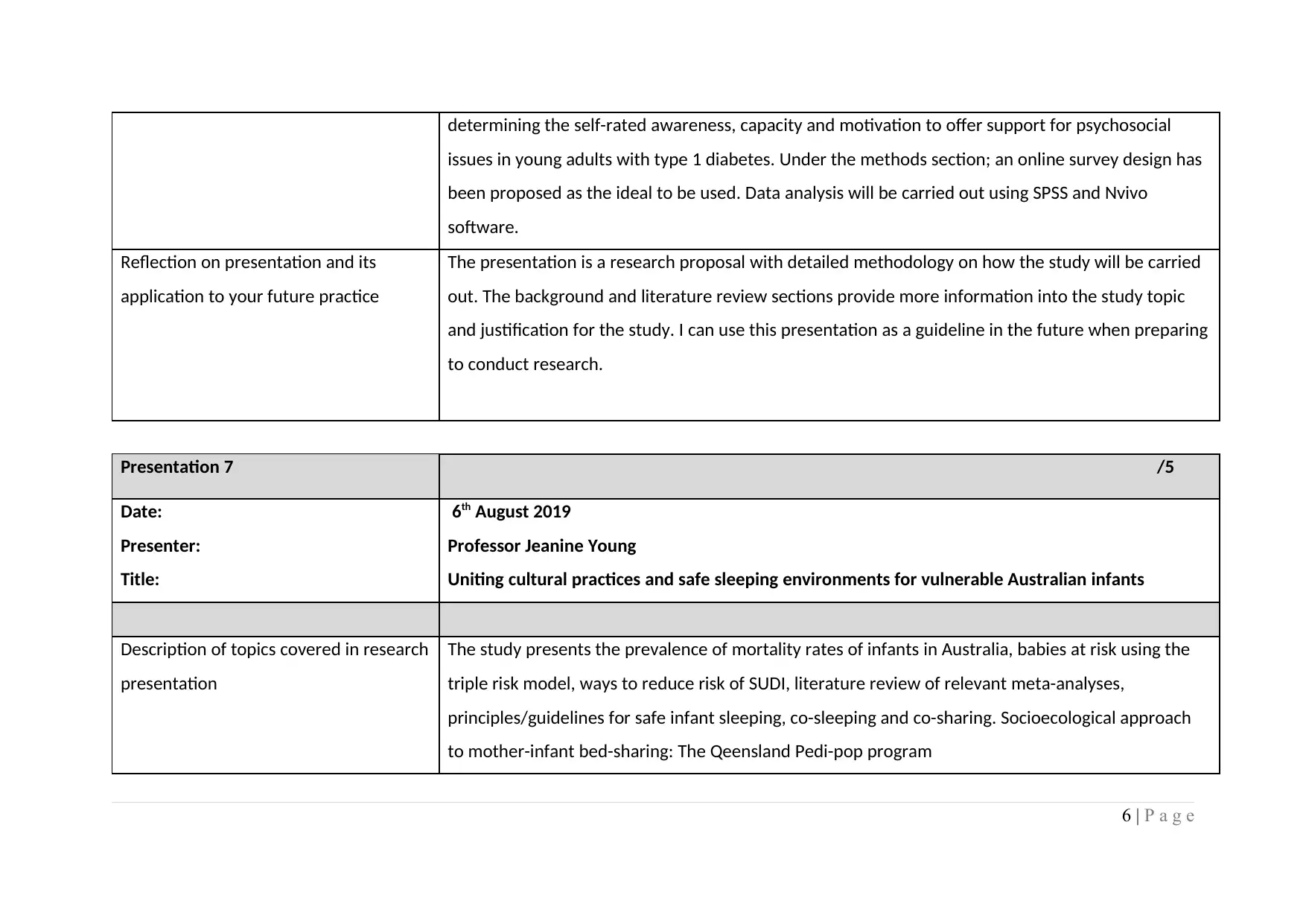
determining the self-rated awareness, capacity and motivation to offer support for psychosocial
issues in young adults with type 1 diabetes. Under the methods section; an online survey design has
been proposed as the ideal to be used. Data analysis will be carried out using SPSS and Nvivo
software.
Reflection on presentation and its
application to your future practice
The presentation is a research proposal with detailed methodology on how the study will be carried
out. The background and literature review sections provide more information into the study topic
and justification for the study. I can use this presentation as a guideline in the future when preparing
to conduct research.
Presentation 7 /5
Date:
Presenter:
Title:
6th August 2019
Professor Jeanine Young
Uniting cultural practices and safe sleeping environments for vulnerable Australian infants
Description of topics covered in research
presentation
The study presents the prevalence of mortality rates of infants in Australia, babies at risk using the
triple risk model, ways to reduce risk of SUDI, literature review of relevant meta-analyses,
principles/guidelines for safe infant sleeping, co-sleeping and co-sharing. Socioecological approach
to mother-infant bed-sharing: The Qeensland Pedi-pop program
6 | P a g e
issues in young adults with type 1 diabetes. Under the methods section; an online survey design has
been proposed as the ideal to be used. Data analysis will be carried out using SPSS and Nvivo
software.
Reflection on presentation and its
application to your future practice
The presentation is a research proposal with detailed methodology on how the study will be carried
out. The background and literature review sections provide more information into the study topic
and justification for the study. I can use this presentation as a guideline in the future when preparing
to conduct research.
Presentation 7 /5
Date:
Presenter:
Title:
6th August 2019
Professor Jeanine Young
Uniting cultural practices and safe sleeping environments for vulnerable Australian infants
Description of topics covered in research
presentation
The study presents the prevalence of mortality rates of infants in Australia, babies at risk using the
triple risk model, ways to reduce risk of SUDI, literature review of relevant meta-analyses,
principles/guidelines for safe infant sleeping, co-sleeping and co-sharing. Socioecological approach
to mother-infant bed-sharing: The Qeensland Pedi-pop program
6 | P a g e
⊘ This is a preview!⊘
Do you want full access?
Subscribe today to unlock all pages.

Trusted by 1+ million students worldwide

Reflection on presentation and its
application to your future practice
The presentation is appropriate because of the increasing infant mortality due to co-sharing of beds.
The Qeensland Pedi-pop program is a good initiative because it also considers the culture of the
Indigenous Australians which encourages sleeping with infants. In my future practice, the
information presented here can be important in devising a different socioecological approach in
different cultures
Presentation 8 /5
Date:
Presenter:
Title:
16th August 2019
Dr Kendall George
Developing and piloting a mobile health intervention for mothers with preterm infants
Description of topics covered in research
presentation
This study is critical because there is a lack of post-discharge support services. The study design
consists of three phases, with an interaction and interface of qualitative and quantitative methods.
The mhealth support program has been proposed as a guide to mothers with preterm babies after
being discharged from hospital.
Reflection on presentation and its
application to your future practice
The mhealth program is a unique innovation that uses technology to help mothers with pre-term
babies to provide healthcare services while at home. The comments made by the users is an
7 | P a g e
application to your future practice
The presentation is appropriate because of the increasing infant mortality due to co-sharing of beds.
The Qeensland Pedi-pop program is a good initiative because it also considers the culture of the
Indigenous Australians which encourages sleeping with infants. In my future practice, the
information presented here can be important in devising a different socioecological approach in
different cultures
Presentation 8 /5
Date:
Presenter:
Title:
16th August 2019
Dr Kendall George
Developing and piloting a mobile health intervention for mothers with preterm infants
Description of topics covered in research
presentation
This study is critical because there is a lack of post-discharge support services. The study design
consists of three phases, with an interaction and interface of qualitative and quantitative methods.
The mhealth support program has been proposed as a guide to mothers with preterm babies after
being discharged from hospital.
Reflection on presentation and its
application to your future practice
The mhealth program is a unique innovation that uses technology to help mothers with pre-term
babies to provide healthcare services while at home. The comments made by the users is an
7 | P a g e
Paraphrase This Document
Need a fresh take? Get an instant paraphrase of this document with our AI Paraphraser
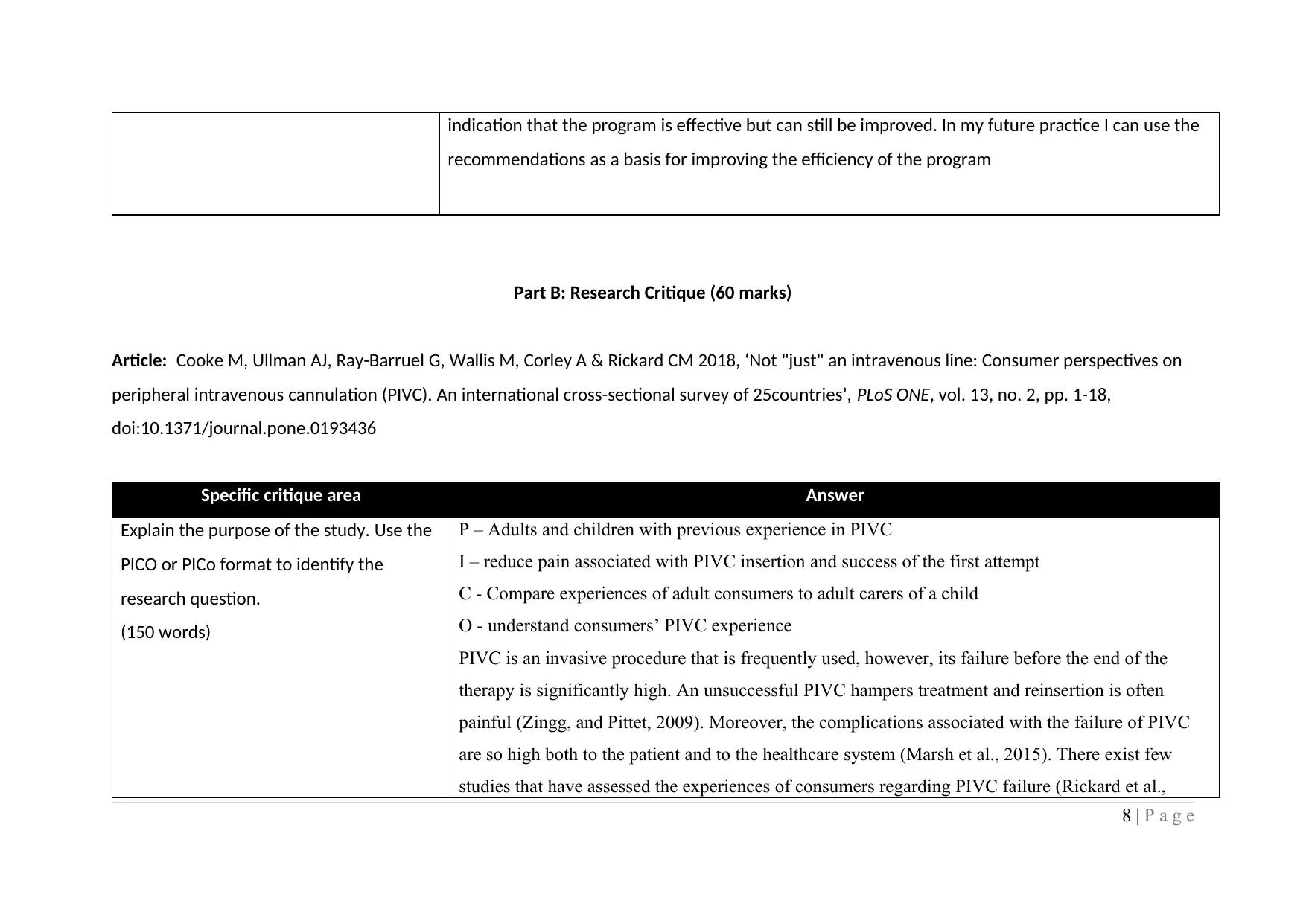
indication that the program is effective but can still be improved. In my future practice I can use the
recommendations as a basis for improving the efficiency of the program
Part B: Research Critique (60 marks)
Article: Cooke M, Ullman AJ, Ray-Barruel G, Wallis M, Corley A & Rickard CM 2018, ‘Not "just" an intravenous line: Consumer perspectives on
peripheral intravenous cannulation (PIVC). An international cross-sectional survey of 25countries’, PLoS ONE, vol. 13, no. 2, pp. 1-18,
doi:10.1371/journal.pone.0193436
Specific critique area Answer
Explain the purpose of the study. Use the
PICO or PICo format to identify the
research question.
(150 words)
P – Adults and children with previous experience in PIVC
I – reduce pain associated with PIVC insertion and success of the first attempt
C - Compare experiences of adult consumers to adult carers of a child
O - understand consumers’ PIVC experience
PIVC is an invasive procedure that is frequently used, however, its failure before the end of the
therapy is significantly high. An unsuccessful PIVC hampers treatment and reinsertion is often
painful (Zingg, and Pittet, 2009). Moreover, the complications associated with the failure of PIVC
are so high both to the patient and to the healthcare system (Marsh et al., 2015). There exist few
studies that have assessed the experiences of consumers regarding PIVC failure (Rickard et al.,
8 | P a g e
recommendations as a basis for improving the efficiency of the program
Part B: Research Critique (60 marks)
Article: Cooke M, Ullman AJ, Ray-Barruel G, Wallis M, Corley A & Rickard CM 2018, ‘Not "just" an intravenous line: Consumer perspectives on
peripheral intravenous cannulation (PIVC). An international cross-sectional survey of 25countries’, PLoS ONE, vol. 13, no. 2, pp. 1-18,
doi:10.1371/journal.pone.0193436
Specific critique area Answer
Explain the purpose of the study. Use the
PICO or PICo format to identify the
research question.
(150 words)
P – Adults and children with previous experience in PIVC
I – reduce pain associated with PIVC insertion and success of the first attempt
C - Compare experiences of adult consumers to adult carers of a child
O - understand consumers’ PIVC experience
PIVC is an invasive procedure that is frequently used, however, its failure before the end of the
therapy is significantly high. An unsuccessful PIVC hampers treatment and reinsertion is often
painful (Zingg, and Pittet, 2009). Moreover, the complications associated with the failure of PIVC
are so high both to the patient and to the healthcare system (Marsh et al., 2015). There exist few
studies that have assessed the experiences of consumers regarding PIVC failure (Rickard et al.,
8 | P a g e

2010; Bolton, 2010). The study purposed at comprehending the Peripheral intravascular
cannula/catheter (PIVC) experiences of consumers; determine the areas of PIVC insertion that the
appropriate care for them: and to compare the adult consumer experiences with adult carers of
children.
Discuss the design used in the research.
(150 words)
The authors used an international, web-based, cross-sectional survey to determine the experiences of
PIVC consumers. The design was appropriate for the study because it is appropriate in describing a
given phenomenon but not to ascertain the cause-and-effect association between variables
(Heiervang, and Goodman, 2011). Additionally, the approach is frequently used to make inferences
regarding potential associations or to collect primary data as a basis for further research (Bell,
Bryman, and Harley, 2018). The current study aimed at comprehending the Peripheral intravascular
cannula/catheter (PIVC) experiences of consumers; determine the areas of PIVC insertion that the
appropriate care for them: and to compare the adult consumer experiences with adult carers of
children, thus making the design the most appropriate for the study. However, cross-sectional
designs do not determine cause and effect which is critical in healthcare studies (Bell et al., 2018).
Due to the high variability of the study population, there are sometimes challenges in putting
together the sampling pool, thus increasing the possibility of sampling bias.
Identify and explain sampling and
recruitment procedures were in the
research.
The authors used a universal, online cross-sectional survey to find out the experiences of the
consumers in the use of PIVC. The social media of the research group – AVATAR (Alliance for
Vascular Access Teaching and Research) was used to invite participants to complete an online,
9 | P a g e
cannula/catheter (PIVC) experiences of consumers; determine the areas of PIVC insertion that the
appropriate care for them: and to compare the adult consumer experiences with adult carers of
children.
Discuss the design used in the research.
(150 words)
The authors used an international, web-based, cross-sectional survey to determine the experiences of
PIVC consumers. The design was appropriate for the study because it is appropriate in describing a
given phenomenon but not to ascertain the cause-and-effect association between variables
(Heiervang, and Goodman, 2011). Additionally, the approach is frequently used to make inferences
regarding potential associations or to collect primary data as a basis for further research (Bell,
Bryman, and Harley, 2018). The current study aimed at comprehending the Peripheral intravascular
cannula/catheter (PIVC) experiences of consumers; determine the areas of PIVC insertion that the
appropriate care for them: and to compare the adult consumer experiences with adult carers of
children, thus making the design the most appropriate for the study. However, cross-sectional
designs do not determine cause and effect which is critical in healthcare studies (Bell et al., 2018).
Due to the high variability of the study population, there are sometimes challenges in putting
together the sampling pool, thus increasing the possibility of sampling bias.
Identify and explain sampling and
recruitment procedures were in the
research.
The authors used a universal, online cross-sectional survey to find out the experiences of the
consumers in the use of PIVC. The social media of the research group – AVATAR (Alliance for
Vascular Access Teaching and Research) was used to invite participants to complete an online,
9 | P a g e
⊘ This is a preview!⊘
Do you want full access?
Subscribe today to unlock all pages.

Trusted by 1+ million students worldwide
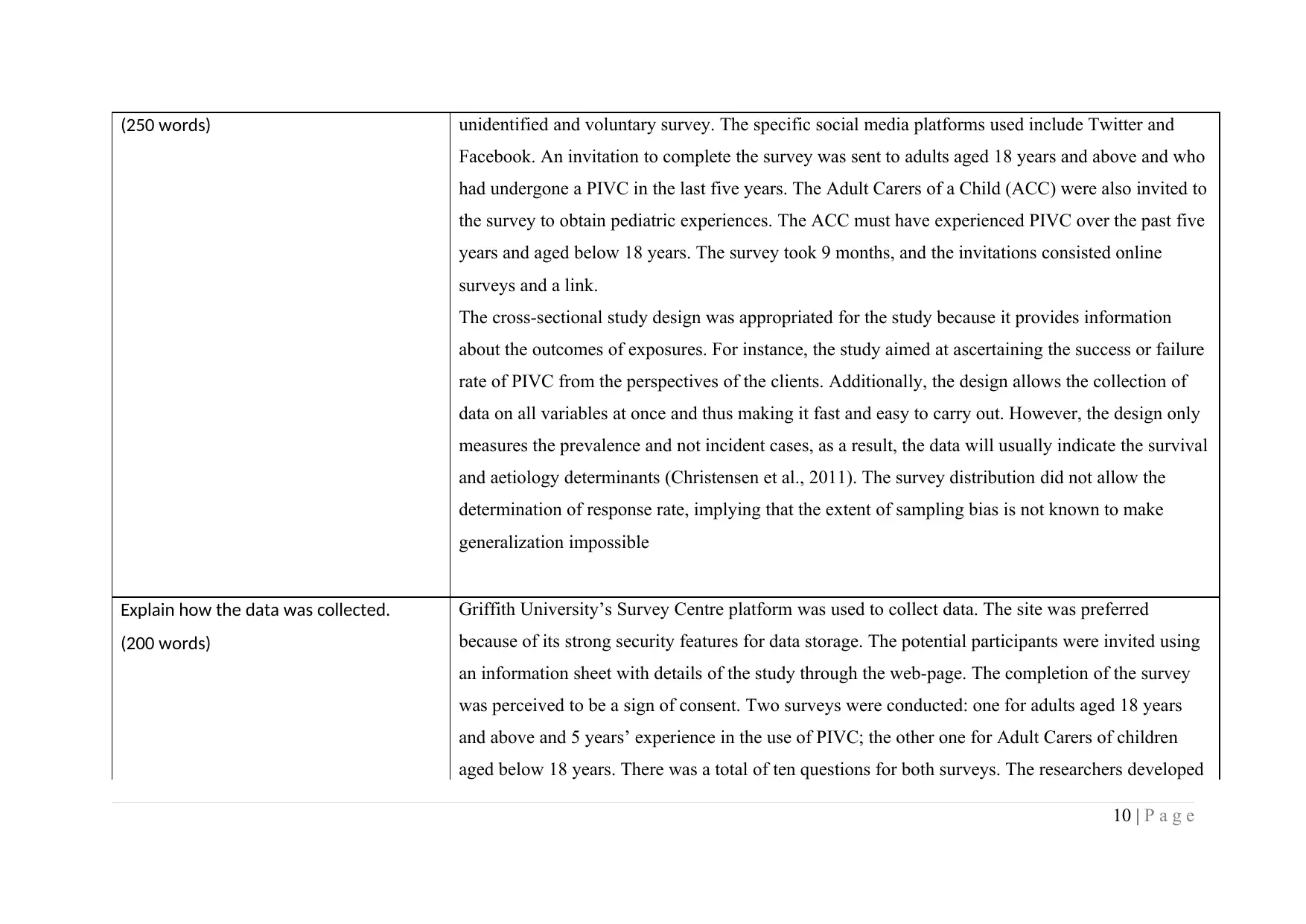
(250 words) unidentified and voluntary survey. The specific social media platforms used include Twitter and
Facebook. An invitation to complete the survey was sent to adults aged 18 years and above and who
had undergone a PIVC in the last five years. The Adult Carers of a Child (ACC) were also invited to
the survey to obtain pediatric experiences. The ACC must have experienced PIVC over the past five
years and aged below 18 years. The survey took 9 months, and the invitations consisted online
surveys and a link.
The cross-sectional study design was appropriated for the study because it provides information
about the outcomes of exposures. For instance, the study aimed at ascertaining the success or failure
rate of PIVC from the perspectives of the clients. Additionally, the design allows the collection of
data on all variables at once and thus making it fast and easy to carry out. However, the design only
measures the prevalence and not incident cases, as a result, the data will usually indicate the survival
and aetiology determinants (Christensen et al., 2011). The survey distribution did not allow the
determination of response rate, implying that the extent of sampling bias is not known to make
generalization impossible
Explain how the data was collected.
(200 words)
Griffith University’s Survey Centre platform was used to collect data. The site was preferred
because of its strong security features for data storage. The potential participants were invited using
an information sheet with details of the study through the web-page. The completion of the survey
was perceived to be a sign of consent. Two surveys were conducted: one for adults aged 18 years
and above and 5 years’ experience in the use of PIVC; the other one for Adult Carers of children
aged below 18 years. There was a total of ten questions for both surveys. The researchers developed
10 | P a g e
Facebook. An invitation to complete the survey was sent to adults aged 18 years and above and who
had undergone a PIVC in the last five years. The Adult Carers of a Child (ACC) were also invited to
the survey to obtain pediatric experiences. The ACC must have experienced PIVC over the past five
years and aged below 18 years. The survey took 9 months, and the invitations consisted online
surveys and a link.
The cross-sectional study design was appropriated for the study because it provides information
about the outcomes of exposures. For instance, the study aimed at ascertaining the success or failure
rate of PIVC from the perspectives of the clients. Additionally, the design allows the collection of
data on all variables at once and thus making it fast and easy to carry out. However, the design only
measures the prevalence and not incident cases, as a result, the data will usually indicate the survival
and aetiology determinants (Christensen et al., 2011). The survey distribution did not allow the
determination of response rate, implying that the extent of sampling bias is not known to make
generalization impossible
Explain how the data was collected.
(200 words)
Griffith University’s Survey Centre platform was used to collect data. The site was preferred
because of its strong security features for data storage. The potential participants were invited using
an information sheet with details of the study through the web-page. The completion of the survey
was perceived to be a sign of consent. Two surveys were conducted: one for adults aged 18 years
and above and 5 years’ experience in the use of PIVC; the other one for Adult Carers of children
aged below 18 years. There was a total of ten questions for both surveys. The researchers developed
10 | P a g e
Paraphrase This Document
Need a fresh take? Get an instant paraphrase of this document with our AI Paraphraser

the questions based on different topics generated from a literature review, after which they were
forwarded to five experts of the AVATAR group who are experienced in clinical practice. The
experts only arrived at a consensus after reviewing the questions three times and after appropriate
changes were made. An online survey was appropriate for this study because of the big sample size
(n=712). Furthermore, the ability of the respondents to answer the questionnaires and then stored
automatically in a survey database made it easy to handle the data with minimal possibility of data
errors (Fenner et al., 2012).
Explain how data was analysed.
(150 words)
Descriptive and inferential statistics were used to analyze the ten questions. The first nine questions
were analyzed using descriptive statistics to determine the interquartile range. The interquartile
range is not sensitive to outliers and therefore critical in determining when a value is an outlier or
when data is not normally distributed (Ritchie et al., 2013). The experiences of the adults and ACCs
were compared using the Mann-Whitney U test, Fisher’s or Chi-square exact test. The Norwood’s
approach was used as a basis for thematic analysis of question ten which was an open-ended
question. The association and pattern between the categories of data were carried out using manual
coding of the feedbacks and systematically examined using an inductive analytic process to enable
the generation of the themes from the data. The title for the themes was carefully selected based on
precision and to ensure inclusivity of all the responses of the participants. The outcomes of data
analysis were presented in the form of tables and sub-themes.
Briefly summarise the results of this study There were 712 participants distributed across 25 countries with the females (87.1%) being the
11 | P a g e
forwarded to five experts of the AVATAR group who are experienced in clinical practice. The
experts only arrived at a consensus after reviewing the questions three times and after appropriate
changes were made. An online survey was appropriate for this study because of the big sample size
(n=712). Furthermore, the ability of the respondents to answer the questionnaires and then stored
automatically in a survey database made it easy to handle the data with minimal possibility of data
errors (Fenner et al., 2012).
Explain how data was analysed.
(150 words)
Descriptive and inferential statistics were used to analyze the ten questions. The first nine questions
were analyzed using descriptive statistics to determine the interquartile range. The interquartile
range is not sensitive to outliers and therefore critical in determining when a value is an outlier or
when data is not normally distributed (Ritchie et al., 2013). The experiences of the adults and ACCs
were compared using the Mann-Whitney U test, Fisher’s or Chi-square exact test. The Norwood’s
approach was used as a basis for thematic analysis of question ten which was an open-ended
question. The association and pattern between the categories of data were carried out using manual
coding of the feedbacks and systematically examined using an inductive analytic process to enable
the generation of the themes from the data. The title for the themes was carefully selected based on
precision and to ensure inclusivity of all the responses of the participants. The outcomes of data
analysis were presented in the form of tables and sub-themes.
Briefly summarise the results of this study There were 712 participants distributed across 25 countries with the females (87.1%) being the
11 | P a g e
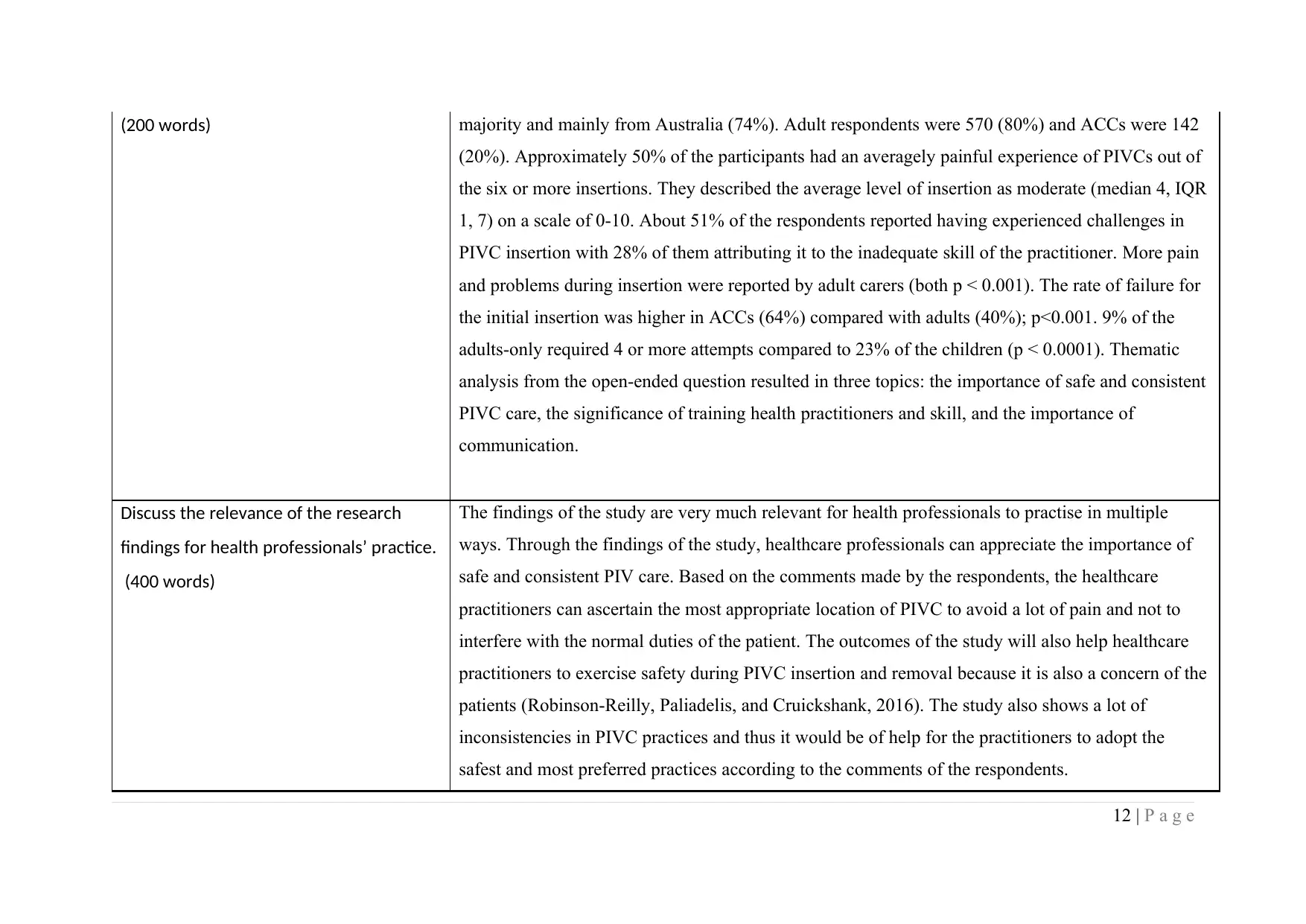
(200 words) majority and mainly from Australia (74%). Adult respondents were 570 (80%) and ACCs were 142
(20%). Approximately 50% of the participants had an averagely painful experience of PIVCs out of
the six or more insertions. They described the average level of insertion as moderate (median 4, IQR
1, 7) on a scale of 0-10. About 51% of the respondents reported having experienced challenges in
PIVC insertion with 28% of them attributing it to the inadequate skill of the practitioner. More pain
and problems during insertion were reported by adult carers (both p < 0.001). The rate of failure for
the initial insertion was higher in ACCs (64%) compared with adults (40%); p<0.001. 9% of the
adults-only required 4 or more attempts compared to 23% of the children (p < 0.0001). Thematic
analysis from the open-ended question resulted in three topics: the importance of safe and consistent
PIVC care, the significance of training health practitioners and skill, and the importance of
communication.
Discuss the relevance of the research
findings for health professionals’ practice.
(400 words)
The findings of the study are very much relevant for health professionals to practise in multiple
ways. Through the findings of the study, healthcare professionals can appreciate the importance of
safe and consistent PIV care. Based on the comments made by the respondents, the healthcare
practitioners can ascertain the most appropriate location of PIVC to avoid a lot of pain and not to
interfere with the normal duties of the patient. The outcomes of the study will also help healthcare
practitioners to exercise safety during PIVC insertion and removal because it is also a concern of the
patients (Robinson-Reilly, Paliadelis, and Cruickshank, 2016). The study also shows a lot of
inconsistencies in PIVC practices and thus it would be of help for the practitioners to adopt the
safest and most preferred practices according to the comments of the respondents.
12 | P a g e
(20%). Approximately 50% of the participants had an averagely painful experience of PIVCs out of
the six or more insertions. They described the average level of insertion as moderate (median 4, IQR
1, 7) on a scale of 0-10. About 51% of the respondents reported having experienced challenges in
PIVC insertion with 28% of them attributing it to the inadequate skill of the practitioner. More pain
and problems during insertion were reported by adult carers (both p < 0.001). The rate of failure for
the initial insertion was higher in ACCs (64%) compared with adults (40%); p<0.001. 9% of the
adults-only required 4 or more attempts compared to 23% of the children (p < 0.0001). Thematic
analysis from the open-ended question resulted in three topics: the importance of safe and consistent
PIVC care, the significance of training health practitioners and skill, and the importance of
communication.
Discuss the relevance of the research
findings for health professionals’ practice.
(400 words)
The findings of the study are very much relevant for health professionals to practise in multiple
ways. Through the findings of the study, healthcare professionals can appreciate the importance of
safe and consistent PIV care. Based on the comments made by the respondents, the healthcare
practitioners can ascertain the most appropriate location of PIVC to avoid a lot of pain and not to
interfere with the normal duties of the patient. The outcomes of the study will also help healthcare
practitioners to exercise safety during PIVC insertion and removal because it is also a concern of the
patients (Robinson-Reilly, Paliadelis, and Cruickshank, 2016). The study also shows a lot of
inconsistencies in PIVC practices and thus it would be of help for the practitioners to adopt the
safest and most preferred practices according to the comments of the respondents.
12 | P a g e
⊘ This is a preview!⊘
Do you want full access?
Subscribe today to unlock all pages.

Trusted by 1+ million students worldwide
1 out of 15
Your All-in-One AI-Powered Toolkit for Academic Success.
+13062052269
info@desklib.com
Available 24*7 on WhatsApp / Email
![[object Object]](/_next/static/media/star-bottom.7253800d.svg)
Unlock your academic potential
Copyright © 2020–2025 A2Z Services. All Rights Reserved. Developed and managed by ZUCOL.

